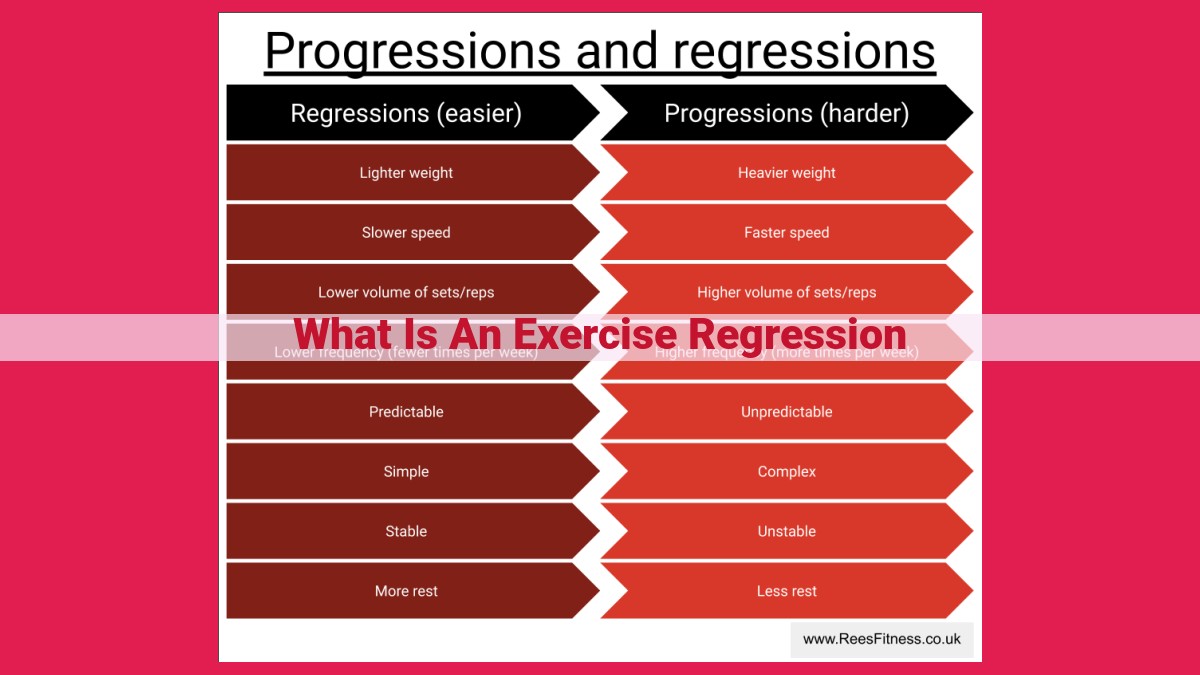Exercise Regression: Optimize Your Fitness Journey Despite Limitations

Exercise regression involves modifying exercises to enhance comfort and safety, especially for individuals with pain, injuries, or physical limitations. By reducing discomfort and improving mobility, regression allows individuals to maintain fitness while respecting their current abilities. Factors to consider when modifying exercises include exercise selection and progression, while examples include squatting with support, using resistance bands instead of weights, or swimming for low-impact cardio. Exercise regression plays a crucial role in enabling individuals to continue exercising safely and effectively, regardless of their limitations.
Exercise Regression: Understanding Its Role in Pain Management and Fitness
If you’re struggling with pain, injuries, or physical limitations, you may have heard about exercise regression. It’s a technique that involves modifying exercises to make them safer and more comfortable for your body. By regressing exercises, you can continue to benefit from exercise without aggravating your pain or discomfort.
What is Exercise Regression?
Exercise regression is the process of altering an exercise to reduce its intensity or complexity. This can be done by:
- Changing the body position: For example, doing a squat on a chair instead of standing
- Reducing the range of motion: For example, doing a partial squat instead of a full squat
- Using less weight or resistance: For example, using a resistance band instead of dumbbells
- Slowing down the exercise: For example, taking longer to complete a bicep curl
The goal of exercise regression is to find a variation of the exercise that you can do without pain or discomfort. This allows you to continue exercising and improving your fitness while minimizing the risk of further injury.
Benefits of Exercise Regression
Exercising should not be painful or discomforting. If you find yourself suffering through workouts, exercise regression might be the solution you need. It involves modifying exercises to make them more accessible and comfortable, offering several advantages that can enhance your fitness journey.
Reduced Discomfort:
Pain can be a major deterrent to exercise. Regression allows you to adapt exercises to minimize discomfort, making workouts more tolerable. By adjusting the intensity, range of motion, or equipment, you can exercise without exacerbating pain or discomfort.
Improved Mobility:
Limited mobility can restrict your ability to perform certain exercises. Regression can help by modifying exercises to fit your current range of motion. This allows you to gradually increase your mobility, improve your flexibility, and ultimately perform more exercises comfortably.
Fitness Maintenance:
Injuries or physical limitations shouldn’t prevent you from maintaining your fitness. Regression allows you to continue exercising within your limitations, preventing deconditioning. By adapting exercises to your current abilities, you can keep your fitness levels up while recovering from injuries or conditions that limit your movement.
Considerations for Exercise Regression
Navigating the world of exercise modifications can be like traversing a winding path. You’re not alone if you’ve ever wondered when and how to adapt exercises for optimal comfort and safety. Thoughtful consideration of exercise selection and progression can make all the difference in your fitness journey.
Exercise Selection: The Art of Finding Your Fit
Choosing the right exercises is the foundation of successful regression. Start by considering your specific limitations. For instance, if you have knee pain, selecting exercises that minimize stress on your joints will be crucial. Bodyweight exercises, like squats with a chair for support, can be a gentler option.
Progression: Small Steps, Big Gains
Once you’ve selected suitable exercises, progression is key. Avoid drastic changes that can strain your body. Instead, gradually increase the intensity or complexity of exercises over time. For example, if you’re starting with wall push-ups, you can transition to knee push-ups as you grow stronger.
Other Essential Factors to Ponder:
- Frequency: Listen to your body and rest when needed. Pushing too hard can lead to setbacks.
- Duration: Start with shorter intervals and gradually increase them as your tolerance improves.
- Warm-up and Cool-down: These are crucial for preparing your body for exercise and aiding recovery.
- Proper Form: Maintain correct technique to maximize benefits and minimize risk of injury.
In summary, exercise regression is not a compromise but an empowering tool. By carefully considering exercise selection, progression, and other factors, you can tailor your fitness plan to meet your unique needs. Embrace this opportunity to keep moving, feel better, and achieve your fitness goals with confidence and joy.
Examples of Exercise Regressions
Squatting
- Standard Squat: Standing with feet shoulder-width apart, lower into a squat by bending your knees and hips, keeping your back straight.
- Regression: Elevated Surface Squat: Place a weight bench or step behind you. Step onto the elevated surface and perform the squat as usual. This reduces the range of motion and weight-bearing pressure.
Resistance Bands
- Standard Resistance Band Bicep Curl: Stand on the band with your feet shoulder-width apart, holding the handles at shoulder height. Curl your arms up towards your shoulders.
- Regression: Assisted Resistance Band Bicep Curl: Sit on the floor or a bench with your feet flat. Loop the band over a pull-up bar or hook. Hold the handles close to your chest and curl, using the band’s assistance to reduce resistance.
Swimming
- Standard Freestyle: Swim with your arms alternating in a windmill motion and your legs kicking in a flutter.
- Regression: Buoyancy-Assisted Freestyle: Use a flotation device such as a kickboard or pool noodle to reduce buoyancy and support your body, making it easier to maintain a horizontal position.
Other Exercise Regressions:
- _Knee-to-Chest Stretch (Regression): Lie on your back with knees bent and feet flat. Bring one knee to your chest and hold for a gentle stretch.
- _Plank (Regression): Support your body on your forearms and toes, forming a straight line from head to heels. Lower your knees to the floor for a modified plank.
- _Push-Up (Regression): Place your hands on a wall or bench at shoulder height. Start with your body further away and gradually move closer to increase resistance.